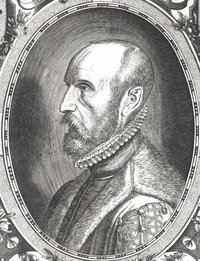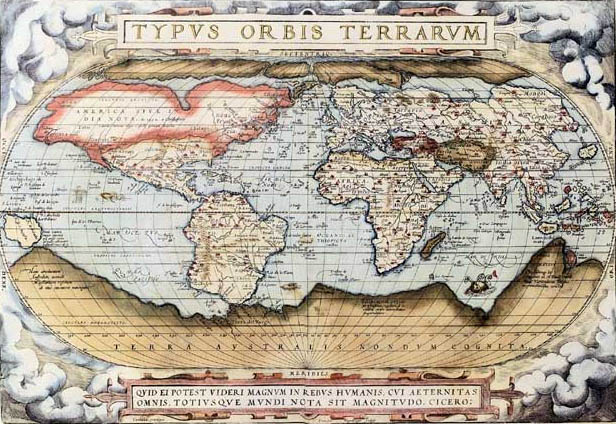Abraham Ortelius
|
|
Abraham Ortelius (Abraham Orthellius, Abraham Ortels, Abraham Wortels) (April 14, 1527 - 1598) was a cartographer and geographer, credited as the creator of the modern atlas. He was born in Antwerp in modern Belgium. A member of the influential Ortelius family of Augsburg, he traveled extensively in Europe. He is specifically known to have traveled throughout the Seventeen Provinces; south and west Germany (e.g., 1560, 1575-1576); France (1559-1560); England and Ireland (1571), and Italy (1578, and perhaps twice or thrice between 1550 and 1558).
Beginning as a map-engraver, in 1547 he entered the Antwerp gild of St Luke as afsetter van Karten. His early career is that of a businessman, and most of his journeys before 1560 are for commercial purposes (such as his yearly visits to the Frankfurt fair). In 1560, however, when travelling with Gerardus Mercator to Trier, Lorraine and Poitiers, he seems to have been attracted, largely by Mercator’s influence, towards the career of a scientific geographer; in particular he now devoted himself, at his friend’s suggestion, to the compilation of that atlas or 'Theatrum Orbis Terrarum' (Theatre of the World) by which he became famous.
In 1564 he completed a "mappemonde", eight-leaved map of the world, which afterwards appeared in the Theatrum. The only extant copy of this great map is in the library of the University of Basle (cf. Bernoulli, Ein Karteninkunabelnband, Basle, 1905, p. 5). He also published a map of Egypt in 1565, a plan of Brittenburg Castle on the coast of the Netherlands, and a map of Asia, before the appearance of his great work.
In 1570 (May 20) was issued, by Gilles Coppens de Diest at Antwerp, Ortelius’ Theatrum Orbis Terrarum, the "first modern atlas" (of 53 maps). Three Latin editions of this (besides a Flemish, a French and a German edition) appeared before the end of 1572; twenty-five editions came out before Ortelius' death in 1598; and several others were published subsequently, for the vogue continued till about 1612. Most of the maps were admittedly reproductions (a list of 87 authors is given by Ortelius himself), and many discrepancies of delineation or nomenclature occur. Errors, of course, abound, both in general conceptions and in detail; thus South America is very faulty in outline, and in Scotland the Grampians lie between the Forth and the Clyde; but, taken as a whole, this atlas with its accompanying text was a monument of rare erudition and industry. Its immediate precursor and prototype was a collection of thirty-eight maps of European lands, and of Asia, Africa, Tartary and Egypt, gathered together by the wealth and enterprise, and through the agents, of Ortelius’ friend and patron, Gilles Hooftman, lord of Cleydael and Aertselaer: most of these were printed in Rome, eight or nine only in Belgium.
In 1573 Ortelius published seventeen supplementary maps under the title of Additamentum Theatri Orbis Terrarum. By this time he had formed a fine collection of coins, medals and antiques, and this produced (also in 1573, published by Philippe Galle of Antwerp) his Deorum dearumque capita ... ex Museo Ortelii (reprinted in Gronovius, Thes. Gr. Ant. vol. vii.). In 1575 he was appointed geographer to the king of Spain, Philip II, on the recommendation of Arias Montanus, who vouched for his orthodoxy (his family, as early as 1535, had fallen under suspicion of Protestantism). In 1578 he laid the basis of a critical treatment of ancient geography by his Synonymia geographica (issued by the Plantin press at Antwerp and republished as Thesaurus geographicus in 1596). In 1584 he brought out his Nomenclator Ptolemaicus, his Parer gon (a series of maps illustrating ancient history, sacred and secular), and his Itinerarium per nonnuilas Galliae Belgicae partes (published at the Plantin press, and reprinted in Hegenitius, Itin. Frisio-Hoil.), a record of a journey in Belgium and the Rhineland made in 1575. Among his last works were an edition of Caesar (C. I. Caesaris omnia quae extant, Leiden, Raphelingen, 1593), and the Aurei saeculi imago, sive Germanorum veterum vita, mores, ritus et religio. (Philippe Galle, Antwerp, 1596). He also aided Welser in his edition of the Peutinger Table in 1598.
In 1596 he received a presentation from Antwerp city, similar to that afterwards bestowed on Rubens; his death, on July 4, 1598, and burial, in St Michael’s Præmonstratensian Abbey church in Antwerp, were marked by public mourning. Quietis cultor sine lite, uxore, prole, reads the inscription on his tombstone.
See Emmanuel van Meteren, Historia Belgica (Amsterdam, 1670); H. E. Wauwermans, Histoire de l’école cartographique belge et anversoise (Antwerp, 1895), and article "Ortelius" in Biographie nationale (Belgian), vol. xvi. (Brussels, 1901); J. H. Hessels, Abrahami Ortelii epistulae (Cambridge, England, 1887); Max Rooses, Ortelius et Plantin (1880); Génard, "Généalogie d’Ortelius," in the Bulletin de la Soc. roy. de Géog. d’Anvers (1880 and 1881)
Adapted from the 1911 Encyclopedia Britannica
The Theatrum Orbis Terrarum inspired a six volume work entitled Civitates Orbis Terrarum edited by Georg Braun and illustrated by Frans Hogenberg with the assistance of Ortelius himself.
External links
- Amsterdam University Library - Abraham Ortelius online exhibit (http://cf.uba.uva.nl/en/collections/maps/ortelius/)
- Cartographica Neerlandica (http://orteliusmaps.com/)de:Abraham Ortelius


